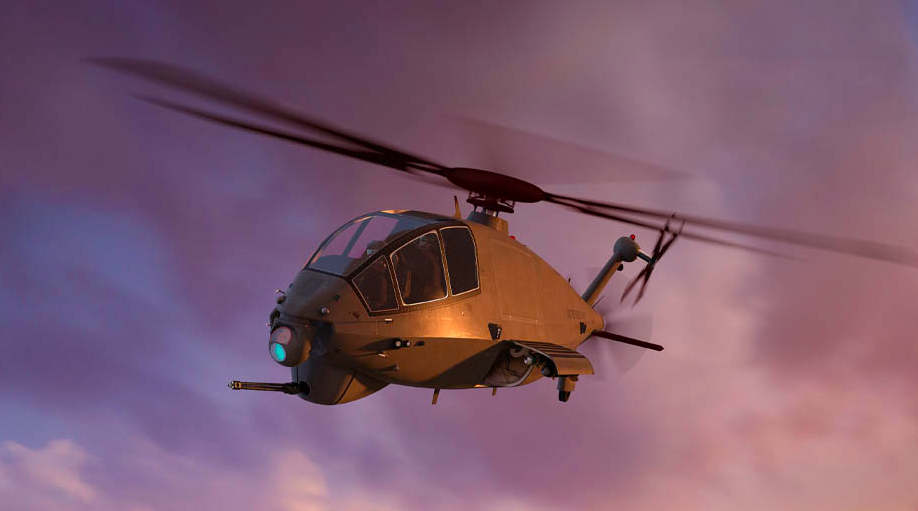
WASHINGTON: After 10 months of strategic silence, aerospace giant Boeing has revealed its design for the Army’s Future Attack Reconnaissance Aircraft, the long-overdue replacement for the retired OH-58 Kiowa scout helicopter.
Boeing’s design draws on the company’s long experience with the AH-64 Apache, the Army’s iconic and agile gunship, Shane Openshaw, Boeing’s FARA program manager, told reporters. Its main rotor, tail rotor, and pusher propeller use the same bullet-resistant materials and advanced manufacturing techniques as the latest Apache upgrade, the AH-64E.
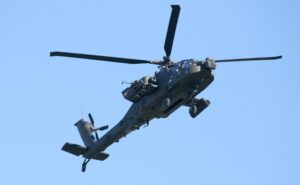
A Boeing AH-64 Apache — note the prominent wing-like “stabilators” projecting from the tail, which improve agility.
The Boeing FARA also builds on extensive work with autonomous flight done on the experimental Unmanned Little Bird (an AH-6 variant) and the Navy’s new MQ-25 Stingray drone. The Army wants FARA to eventually become what it calls “optionally manned,” able to fly with two pilots, one or none, depending on the mission. But it hasn’t asked for that capability in the early models. Boeing’s design will have at least some ability to fly by itself from the very beginning, Openshaw said.
(Sikorsky and Bell have also talked to us about their autonomous aircraft experiments).
“It would be feasible to expect the prototype aircraft to be able… to start, taxi, take-off, perform its mission, return, land, taxi, and shut down autonomously,” he said, without a human either on board or flying the aircraft by remote control. (In test flights, there’d be a human pilot aboard as a backup, just in case).
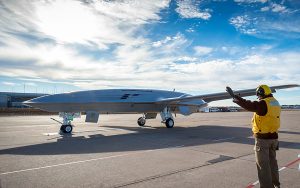
Boeing MQ-25 Stingray prototype, an unmanned aerial refueling tanker
How complicated a mission are we talking about? “In the near term, the prototype phase, it’s the ability to go out to a destination and perform some rudimentary tasks,” he said. But with rapid advances in robotics and AI, he expects the limiting factor to be the Army’s willingness to let machines make decisions in combat, not the technology itself.
“It will be less of a technology limitation,” he said, “[than] there’ll be concern about what the rules of engagement might be… The capabilities will move faster than the rules of engagement will.”
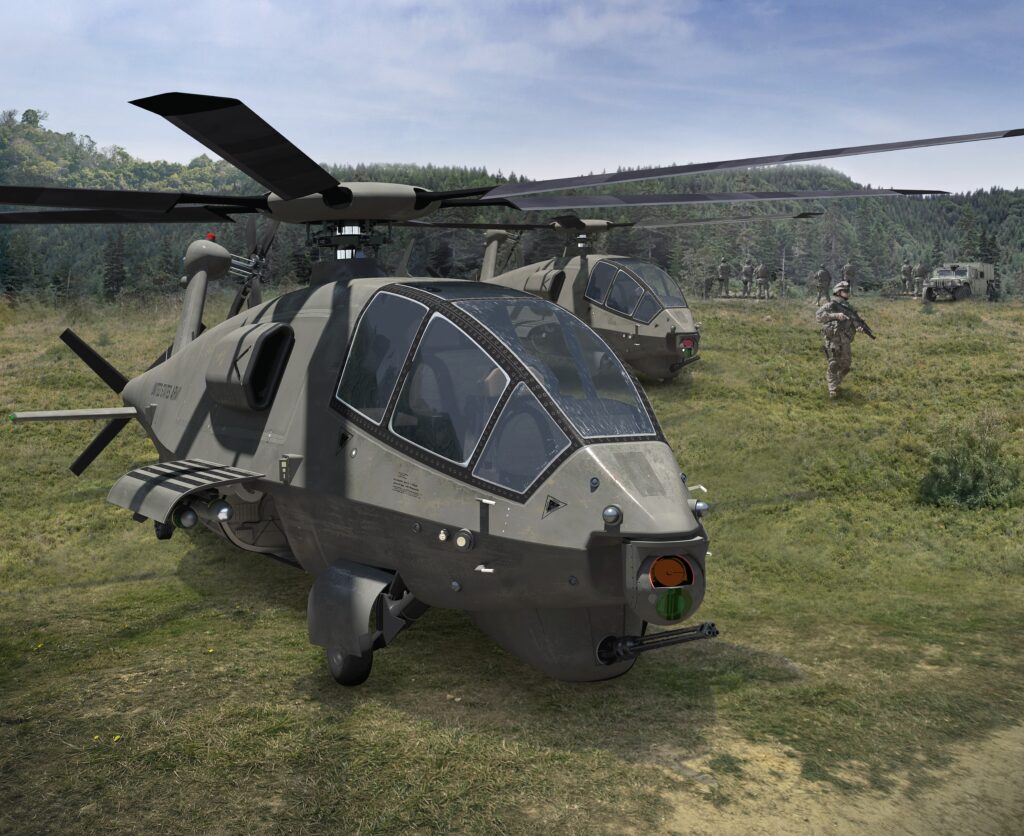
Boeing’s proposed design for the Army’s Future Attack Reconnaissance Aircraft (FARA)
Feature By Feature
Last April, the Army chose five teams to develop detailed designs for FARA. This month, the service will pick two contenders to build full-up prototypes for competitive flight tests. Four of those teams have been touting their designs for months to everybody who would listen. But Boeing, leery of revealing anything to its rivals, has waited until now, after everyone has submitted their final proposals to the Army and it’s too late to steal each others’ ideas.
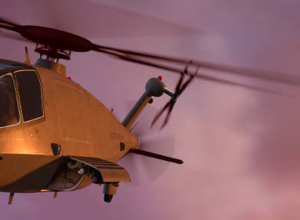
Close-up on the back half of the Boeing FARA design, showing the main rotor, tail rotor, pusher propeller, stabilator, and the open weapons bay.
So what was Boeing protecting? The Boeing FARA – which, unlike its competitors, still lacks a snazzy name – looks at first glance like a conventional helicopter. But conventional helicopters can’t achieve the Army’s requirement to streak at low altitude across future battlefields without being shot down. To meet that need for speed, every competitor has submitted something novel, but Boeing’s design combines more different features than any of its rivals.
“Main features?” Openshaw said. “It’s a single-main-rotor, thrust-compound helicopter, fly-by-wire, single-engine, with no wing.”
No wing? I asked. Those flat surfaces sticking out on either side by the tail sure look like wings, or at least winglets…
They’re not, Openshaw assured me. “That’s a horizontal stabilizer at the tail,” he said. “It functions very much like the stabilator on an Apache” — which is also designed for high agility at low altitude.
Besides helping the aircraft maneuver, I pressed, does it provide lift? A lot of the other FARA competitors have wings for when the main rotor can’t provide enough lift.
“It’s not a primary lift mechanism, it’s more of a trim and balancing system on the back of the aircraft,” he said. (Emphasis ours). “It will provide some lift in the aft for the tail, but not as a primary lifting surface.”
Let’s break down the aircraft’s features.
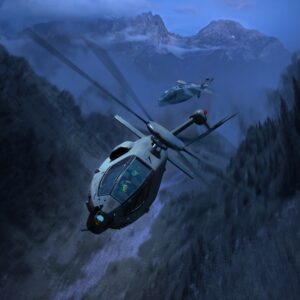
Boeing FARA design
Most obviously, there’s a single main rotor blade on the top of the Boeing FARA aircraft, to provide lift and thrust, and a much smaller tail rotor, to provide stability. (Without the tail rotor counteracting the torque of the main rotor, the aircraft would just spin in circles). This is how most conventional helicopters work, and three of the five FARA competitors share the single-main-rotor-plus-tail-rotor combination: Bell, Karem, as well as, we now know, Boeing.
CORRECTED AVX Configuration The alternative configuration is found on Sikorsky’s Raider-X and AVX. Both have two rotors mounted one atop the other on the same shaft (“coaxial”), spinning in opposite directions (“counter-rotating”) to balance torque without the need for a tail rotor.
But helicopter-style rotors run into aerodynamic difficulties as speed increases, so each competitor has had to figure out another way to achieve the velocities the Army wants. Part of Boeing’s solution is a pusher propeller at the tail of the aircraft: When the pilot needs more speed and the main rotor can no longer deliver it, they can ramp up that prop for extra thrust.
That’s a feature Boeing shares with both Sikorsky’s Raider-X and the Karem AR-40. The difference is where that pusher propeller fits. Since Sikorsky doesn’t need a tail rotor for stability, it just replaces it with the prop. But Karem and Boeing do need tail rotors, at least in certain flight modes. So how do they add a tail prop as well?
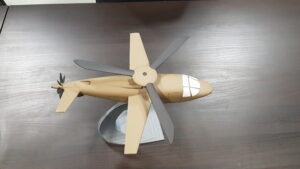
Karem model of their Future Attack Reconnaissance Aircraft (FARA) proposal at AUSA 2019. (Courtesy Vertical Flight Society)
Karem’s ingenious but mechanically complex solution is to make one mechanism serve double duty. The pusher prop flips to one side to act as a tail rotor when required. Boeing, by contrast, sticks both a tail rotor and a pusher propeller on the tail, one atop the other.
Boeing’s approach is mechanically much more straightforward, in keeping with the company’s push to keep its FARA design as simple — and therefore affordable — as possible. But the aerodynamics of two systems in close proximity must be complex, I noted, not to mention unnerving for ground crews trying to work around this cuisinart-like assembly of whirring blades.
“Those are two outstanding questions that we asked ourselves early,” Openshaw replied. “We’ve been in the wind tunnel … testing specifically that tail rotor and prop interaction, with the main rotor [as well].” That data helped refine the design a lot, he said.
“In terms of the cuisinart question,” he continued, “when we’re on the ground around ground crews, the propeller will be … clutched and stationary.” If the pilot wanted, they could engage the prop to help taxi around the airfield, he said, in which case it’d present the same safety issues as any small propeller aircraft. (With one advantage: the blades are on the back of the aircraft, not the front).
While the pusher propeller provides forward thrust, thrust alone is not enough. You also need upwards lift to keep the aircraft in the air. Helicopters rely on their rotors for both lift and thrust, but, again, the aerodynamics of that don’t work at high speeds. Airplanes have wings – and so do three of the five FARA designs: AVX, Bell, and Karem. Sikorsky relies on its unique ultra-rigid dual rotors for both lift and thrust (we explain how that works here and here). As for the Boeing FARA, it’s unclear. While Openshaw insists the wing-like stabilator at the back doesn’t provide most of the lift, he wouldn’t say how much of a boost it provided at high speeds.
There are many other features we can’t tell from the handful of pictures Boeing has provided, but Openshaw and the press release did give a few details. Their FARA will definitely have the digital “fly by wire” controls that are now standard on new aircraft, the company’s press release confirms. There will be “a single engine” rather than two, which is generally lighter and more efficient, although it leaves you without anything to limp home on if that one engine fails. Finally, the streamlined fuselage requires the pilot and co-pilot to sit one behind the other, the tandem arrangement common on high-speed aircraft. Many pilots prefer side-by-side seating, which can make it easier to work together.
Will Boeing’s mix of features provide what the Army wants?
“The fly-by-wire design leverages more than 65 years of rotorcraft experience, proven advanced and additive manufacturing technology, and product commonality driving down risk and costs,” Mark Cherry, general manager of Boeing’s famed Phantom Works, said in a statement. “The system will provide seamless capability within the Army ecosystem to include Long-Range Precision Fires” – i.e. FARA will help find targets for surface-to-surface missiles – “and Air-Launched Effects” – i.e. mini-drones for attack, reconnaissance, and electronic warfare launched by FARA itself.
Of course, we can’t tell that from a picture, so we’ll have to take Boeing’s word on it. But it’s the Army, which has the full proposals from all five competitors, that will decide.
In a ‘world first,’ DARPA project demonstrates AI dogfighting in real jet
“The potential for machine learning in aviation, whether military or civil, is enormous,” said Air Force Col. James Valpiani. “And these fundamental questions of how do we do it, how do we do it safely, how do we train them, are the questions that we are trying to get after.”


























